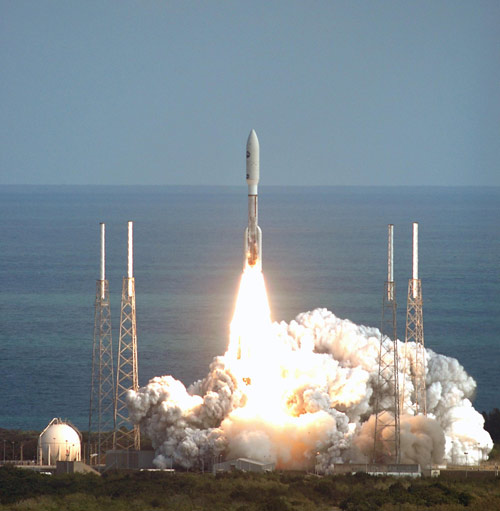New Horizons on Track for Jupiter

Aspacecraft headed for the Solar System's edge has aimed itself at the planetJupiter in a long-distance slingshot on toward Pluto.
NASA's NewHorizons probe fired its thrusters in two brief maneuvers - one on Jan. 30and an earlier event on Jan. 28 - for a total speed change of about 40 miles perhour (or about 18 meters per second). Launchedon Jan. 19, New Horizons carries seven primary instruments on a mission tostudy Pluto, its moons and the icy Kuiper Belt objects beyond the ninth planet.
Athird, final trajectory maneuver is set for Feb. 18, but New Horizons launchplaced it so close to its flight path that the probe has managed save much morehydrazine propellant for later use than expected, APL spokesperson Mike Buckleytold SPACE.com. The probe will swing past Jupiter on Feb. 28, 2007 anduse the planet's gravity as a boost toward Pluto, he added.
"We're on ourway to an exciting Jupiter encounter and a date with destiny at Pluto," saidNew Horizons principal investigator Alan Stern,of the Southwest Research Institute in Boulder, Colorado.
Stern willcelebrate the centennial anniversary of the birth of astronomer ClydeTombaugh, who discovered Pluto in 1930, on Feb. 4 with a presentation atthe University of Kansas in Lawrence, Kansas.
Tombaughdiscovered Pluto on Feb. 18, 1930 at Flagstaff, Arizona's Lowell Observatory.The University of Kansas' Clyde Tombaugh Observatory is named after theastronomer, who died in 1997. [Click here for moreinformation on the centennial Tombaugh discussion.]
- Derelict Booster to Beat Pluto Probe to Jupiter
- NASA Launches Probe to Solar System's Edge
- Reaching for the Edge: New Horizons Spacecraft Bound for Pluto
Breaking space news, the latest updates on rocket launches, skywatching events and more!

Tariq is the award-winning Editor-in-Chief of Space.com and joined the team in 2001. He covers human spaceflight, as well as skywatching and entertainment. He became Space.com's Editor-in-Chief in 2019. Before joining Space.com, Tariq was a staff reporter for The Los Angeles Times covering education and city beats in La Habra, Fullerton and Huntington Beach. He's a recipient of the 2022 Harry Kolcum Award for excellence in space reporting and the 2025 Space Pioneer Award from the National Space Society. He is an Eagle Scout and Space Camp alum with journalism degrees from the USC and NYU. You can find Tariq at Space.com and as the co-host to the This Week In Space podcast on the TWiT network. To see his latest project, you can follow Tariq on Twitter @tariqjmalik.
